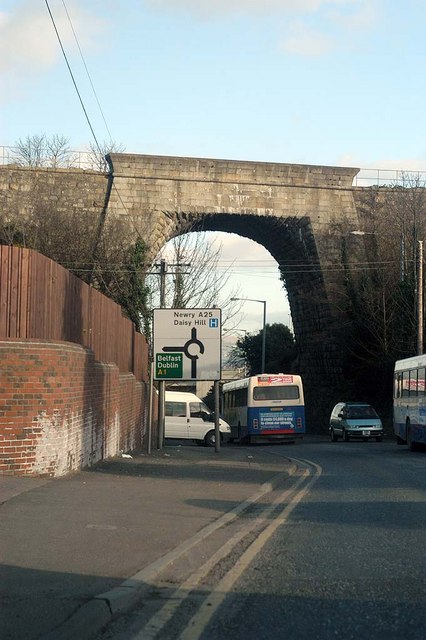MacNeill's Egyptian Arch on:
[Wikipedia]
[Google]
[Amazon]
 Macneill's Egyptian Arch is a
Macneill's Egyptian Arch is a
 Macneill's Egyptian Arch is a
Macneill's Egyptian Arch is a railway bridge
A bridge is a structure built to span a physical obstacle (such as a body of water, valley, road, or railway) without blocking the path underneath. It is constructed for the purpose of providing passage over the obstacle, which is usually somet ...
in Newry
Newry (; ) is a City status in Ireland, city in Northern Ireland, standing on the Newry River, Clanrye river in counties County Down, Down and County Armagh, Armagh. It is near Republic of Ireland–United Kingdom border, the border with the ...
, Northern Ireland
Northern Ireland ( ; ) is a Countries of the United Kingdom, part of the United Kingdom in the north-east of the island of Ireland. It has been #Descriptions, variously described as a country, province or region. Northern Ireland shares Repub ...
. Construction was completed in 1851 for the Dublin and Belfast Junction Railway Company and was the result of collaboration between engineer Sir John Macneill and constructor William Dargan
William Dargan MRDS (28 February 1799 – 7 February 1867) was arguably the most important Irish engineer of the 19th century and certainly the most important figure in railway construction. Dargan designed and built Ireland's first rail ...
. Locally known as the Egyptian Arch, the rail bridge passes over the Newry– Camlough Road, in the County Armagh
County Armagh ( ) is one of the six counties of Northern Ireland and one of the traditional thirty-two counties of Ireland. It is located in the Provinces of Ireland, province of Ulster and adjoins the southern shore of Lough Neagh. It borders t ...
half of Newry.
It is located approximately 5 miles from the border between Northern Ireland and the Republic of Ireland
Ireland ( ), also known as the Republic of Ireland (), is a country in Northwestern Europe, north-western Europe consisting of 26 of the 32 Counties of Ireland, counties of the island of Ireland, with a population of about 5.4 million. ...
on the Dublin–Belfast railway line. It is located less than 1 mile along the line from the 18 Arches viaduct, also known as the Craigmore Viaduct Craigmore may refer to one of the following places:
* Craigmore (hill), in the Trossachs, Scotland
* Craigmore, part of Rothesay, Isle of Bute, Scotland
* Craigmore, Nova Scotia, Canada
* Craigmore, South Australia
**Craigmore High School
**Craigm ...
.
The Egyptian Arch gained its name from its resemblance to the ''nemes
Nemes () consisted of pieces of striped head cloth worn by pharaohs in ancient Egypt. It covered the whole crown and behind of the head and nape of the neck (sometimes also extending a little way down the back) and had lappets, two large flaps ...
'' headdress worn by Ancient Egypt
Ancient Egypt () was a cradle of civilization concentrated along the lower reaches of the Nile River in Northeast Africa. It emerged from prehistoric Egypt around 3150BC (according to conventional Egyptian chronology), when Upper and Lower E ...
ian pharaoh
Pharaoh (, ; Egyptian language, Egyptian: ''wikt:pr ꜥꜣ, pr ꜥꜣ''; Meroitic language, Meroitic: 𐦲𐦤𐦧, ; Biblical Hebrew: ''Parʿō'') was the title of the monarch of ancient Egypt from the First Dynasty of Egypt, First Dynasty ( ...
s. The bridge was selected for the design of the £1 coin
The British one pound (£1) coin is a denomination of sterling coinage. Its obverse has featured the profile of Charles III since 2024 and bears the Latin engraving CHARLES III D G REX () F D (), which means 'Charles III, by the grace of God, ...
to represent Northern Ireland for 2006. All four of the bridge design pound coins for each constituent part of the UK were designed by wood engraver Edwina Ellis in a Royal Mint
The Royal Mint is the United Kingdom's official maker of British coins. It is currently located in Llantrisant, Wales, where it moved in 1968.
Operating under the legal name The Royal Mint Limited, it is a limited company that is wholly ow ...
design competition.
The bridge was also the location of the Egyptian Arch Ambush of 13 December 1920.
References
{{Places of Interest in County Armagh Railway bridges in Northern Ireland Bridges in Northern Ireland Buildings and structures in County Armagh Newry Bridges completed in 1851 Grade B+ listed buildings Arch bridges in the United Kingdom 1851 establishments in Ireland